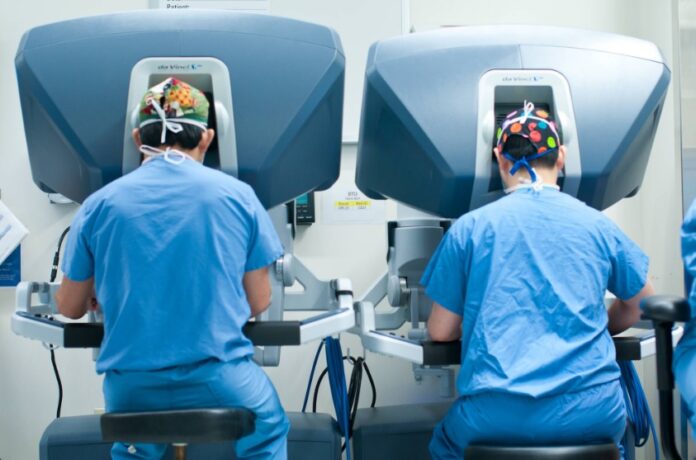
The field of robotic surgery has revolutionized the way complex medical procedures are performed. To ensure safety and precision, robotic surgery demands a unique set of skills. To master robotic surgery, surgeons must acquire and refine foundational skills, progressing systematically from basic techniques to advanced competencies.
Robotic surgery is inherently different from traditional techniques. It involves complex systems and instruments that demand a high level of coordination, dexterity, and decision-making. Acquiring foundational skills ensures that surgeons can perform procedures with the necessary accuracy and fluidity. Moreover, these skills are critical in minimizing errors and complications, essential for patient safety.
This article explores the essential robotic surgical skills, providing insights into their development and evaluation.
1. Mastering the Fundamentals
At the core of robotic surgery are fundamental skills that form the bedrock for more advanced procedures. These include:
a. EndoWrist Manipulation
EndoWrist instruments mimic the dexterity of the human wrist, enabling intricate movements within the surgical site. Proficiency in manipulating these instruments is critical, requiring surgeons to master tasks like clutching, rotating, and precise positioning.
b. Three-Dimensional Vision and Camera Control
Robotic systems provide immersive 3D visualization, which enhances depth perception. Effective camera control, ensuring optimal focus and angles, is vital. This involves steady hand coordination and the ability to anticipate procedural needs.
c. Coordination and Clutching
Coordinating robotic arms while managing clutch controls ensures smooth transitions between tasks. This skill is fundamental for maintaining fluidity and minimizing unnecessary instrument movement.
2. Virtual Reality (VR) Simulation Training
Simulation-based training is a cornerstone of robotic surgery education. Virtual reality platforms offer an ideal environment to develop technical skills in a controlled setting. Key exercises include:
- Pick and Place Tasks: Enhancing hand-eye coordination and spatial awareness.
- Camera Targeting Drills: Refining camera navigation and positioning.
- Peg Board Tasks: Improving dexterity and precision in instrument handling.
Benchmarks for competency are often set based on expert performance scores, with standards like achieving 75% of the mean expert score being widely adopted. These benchmarks ensure that trainees progress systematically and adequately prepare for advanced training stages.
3. Dry Lab Training
Dry labs offer a cost-effective way to practice surgical tasks using robotic systems. By utilizing materials such as beads, sutures, and anatomical models, trainees can simulate cutting, suturing, and grasping exercises. Key benefits include:
- Realistic Console Experience: Trainees practice on the da Vinci Surgical System console, gaining familiarity with its interface.
- Troubleshooting Skills: Dry labs provide an opportunity to learn camera adjustments, instrument calibration, and console controls.
However, dry labs lack standardized assessment methods, necessitating close supervision by expert trainers to provide meaningful feedback.
4. Wet Lab Training
To simulate actual surgical conditions, wet labs use biological tissues, such as frozen animal parts, human body parts, or live animal models. These sessions enable trainees to:
- Experience tissue handling and response to robotic instruments.
- Practice vascular control and diathermy techniques.
- Develop skills in suturing and dissection under near-live conditions.
Although wet labs offer unparalleled realism, they come with challenges, such as high costs and limited availability, especially for live animal models.
5. Structured Operating Room Training
Once foundational skills are mastered, trainees transition to operating room (OR) training. This phase follows a modular approach:
- Stepwise Progression: Trainees begin with simple tasks, gradually taking on more complex responsibilities under mentor supervision.
- Dual Console Systems: Dual consoles allow mentors to intervene seamlessly, increasing trainee operating time and confidence.
- Tele-Mentoring: Emerging technologies enable remote mentoring, offering real-time guidance and expanding access to expert feedback.
6. Developing Non-Technical Skills
While technical proficiency is paramount, non-technical skills are crucial to surgical success. These include:
- Teamwork and Communication: Effective collaboration among surgical teams reduces errors and enhances patient safety.
- Decision-Making: Rapid, informed decisions are critical in dynamic surgical environments.
- Situational Awareness: Understanding the overall surgical scenario and anticipating potential complications are vital.
Training programs like Non-Technical Skills for Surgeons (NOTSS) and Oxford NOTECHS II provide structured approaches to developing these competencies.
7. Competency-Based Assessments
Competency assessment ensures that trainees are ready to progress through various training stages. Methods include:
- Robotic Objective Structured Assessments of Technical Skills (R-OSATS): Scoring drills based on depth perception, accuracy, tissue handling, dexterity, and efficiency.
- Benchmarks for Proficiency: Setting minimum scores, such as 14 out of 20 for R-OSATS drills, ensures objective evaluation.
- Crowd-Sourced Assessments: Recorded drills assessed by a diverse pool of experts provide a feasible alternative to in-person evaluations.
Conclusion
The pathway to mastering robotic surgery involves a blend of technical and non-technical skill development supported by rigorous training and evaluation. Trainees can achieve the competency required to perform robotic procedures with precision and safety by emphasizing proficiency at every stage- from VR simulations to live surgeries. As technology and training methods continue to evolve, the future of robotic surgery promises even more incredible advancements, ensuring optimal outcomes for patients worldwide.





















